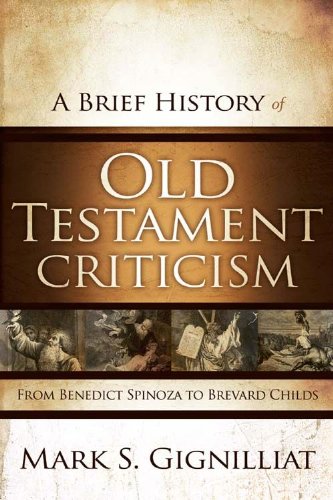A Brief Book Summary from Books At a Glance
By Benjamin Montoya
About the Author
Mark Gignilliat (Ph.D., University of St. Andrews) is assistant professor of divinity at Beeson Divinity School in Alabama.
Introduction
History is a topic that often garners little interest from people. The history of Old Testament study/criticism is one that attracts perhaps even less. Why bother it? Who are some of the key figures? How have their works and various schools-of-thought impacted the study of the OT today? Consider this helpful and accessible introduction to this much larger topic as a way to begin answering these questions.
Table of Contents
Chapter 1 Benedict Spinoza
Chapter 2 W. M. L. de Wette
Chapter 3 Julius Wellhausen
Chapter 4 Hermann Gunkel
Chapter 5 Gerhard von Rad
Chapter 6 William Foxwell Albright
Chapter 7 Brevard S. Childs
Summary
Chapter 1: Benedict Spinoza (1632-1677)
The first person to begin our consideration of the vast history of OT criticism is Benedict Spinoza. He makes two assumptions that drive his work. First, the Bible is a product of human history and evolution and is to be read considering its natural history. Second, philosophy and theology must be understood as two distinct disciplines because philosophy is concerned with truth whereas theology is morality. Thus, when he approaches the text of the Bible, there is an immediate rejection of miracles and a complete denial of the supernatural. Given just how much of the OT contains miracles and the supernatural, his assumptions regarding the nature of the Bible drastically change what comes out of his interpretation. He also argued that the soul does not live on, that Moses did not write the Pentateuch, that the Torah had any revelatory character, and that Israel did not have the status of the elect of God.
His work is important to consider because it sets the trajectory for the modern-critical approach to OT exegesis. Because of the kinds of denials he makes, exegesis turns into an effort to deny what does not seem readily amenable to human reason. Furthermore, exegesis becomes about trying to see the text’s historical reference, setting, and immediate intention. He writes:
To formulate the matter succinctly, I hold that the method of interpreting Scripture does not differ from the [correct] method of interpreting nature, but rather is wholly consonant with it. The [correct] method of interpreting nature consists above all in constructing a natural history, from which we derive the definitions of natural things, as from certain data. Likewise, to interpret Scripture, we need to assemble a genuine history of it and to deduce the thinking of the Bible’s authors by valid inferences from this history, as from certain data and principles.
Part of what drives Spinoza’s views is his acceptance of modernity’s most cherished claims: autonomous intellectual pursuits, dismissal of dogmatic tradition, naturalism, and the affirmation of the Cartesian “I,” (I think therefore I am). When humans become the authority of everything as modernity claims, then whatever does not fit that mold has to be removed.
Spinoza’s work would influence many within the history of OT studies. For him and those who follow him, the OT becomes primarily a history book. That is not to say that a concern for genre and the like do not receive consideration. But this larger assumption regarding the un-supernatural nature of the Bible remains. Modernity has so changed the tide of OT criticism for Spinoza that Scripture truly has been dislocated from revelation for a focus on the history contained therein.
Chapter 2: M. L. de Wette (1780-1849)
The next scholar to consider is W. M. L. de Witte. His focus is that history recorded in the OT becomes our connection to Israel’s history of religion. Given the kind of groundwork that Spinoza laid regarding his view of the naturalistic nature of the OT, de Witte picked up from there and focused elsewhere. One interesting, and perhaps frustrating, historical note is that his dissertation was only sixteen pages in length. Back then dissertations were evaluated in terms of their quality, not length, as they are today.
[To continue reading this summary, please see below....]The remainder of this article is premium content. Become a member to continue reading.
Already have an account? Sign In
